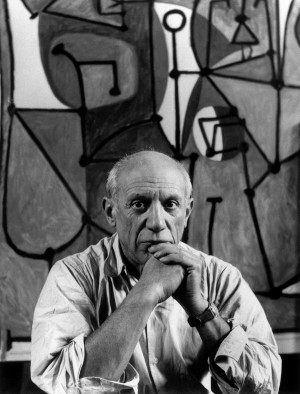‘Picasso: Black and White’ and All the Shades of Gray
It’s worth noting that should you make the trip to Barcelona, no fewer than 58 studies of Las Meninas that Picasso painted in 1957 can be viewed at the Museu Picasso. The entire suite is fully preserved there and is the only series of the artist that remains together.
Cubism rears its head but does not hold center stage in this exhibit. Though Picasso’s name was linked with Georges Braque for their pioneering works, Picasso’s artistic path was to be considerably richer than such explorations alone. While breaking apart an image into any number of facets and reordering them into a new way of seeing was a prodigious undertaking, more arresting is his pivotal canvas, The Milliner’s Workshop from 1926, on loan from the Centre Pompidou in Paris. The free associations attributed to the Surrealists are apparent in the lavish weaving of black and white arabesques. Here we see the biomorphic shapes Picasso does so well. The interlacing swirls are absolutely hypnotic, maybe even more so to an untrained eye. It’s a master jigsaw puzzle for the ages.
Rest assured that humor, passion and even a light-hearted vibrancy will have their say on your journey. As Patrick O’Brian remarks in his recent biography of the artist, “He was a man about as lonely as the sun, but one who glowed with much the same fierce, burning life.” That life force — Picasso’s sheer engagement in its everyday possibilities — is evident in two cubistic portraits from the ’30s. In one, Picasso shows us a man busily eating an ice cream cone and in another, a little girl with large curls and a pacifier, poised underneath a large chair. Remember, this is Cubism at play, but there is enough delightful detail in both images for any good eye to unravel. This is possibly Maya, the love child he shared with his muse, Marie-Thérèse Walter.
A generous series of images with Marie-Thérèse as the central subject can be seen here. A viewer favorite and chosen as a key publicity image for the exhibit is Marie-Thérèse, Face and Profile (Marie-Thérèse, face et profil), from 1931. There is an indisputable elegance at work in the split contours of the full moon-face intersecting with the subject’s profile. The swirling majesty of the artist’s lines in this portrait are beautifully rendered. Another rendering more naturalistic though still highly stylized is his Head of a Woman, Right Profile (Marie-Thérèse), and here, the large, limpid eye and the delicacy of the profile suggest the artist’s own infatuation with his subject.
One particular sculpture of Marie-Thérèse on display on the main floor rotunda (Bust of a Woman) gives a fullness and power to the woman if not the delicacy of other two-dimensional images. Preferable to some will undoubtedly be the wonderful cutouts in metal from 1954, encased in Lucite boxes. These sculptures of Sylvette, a later muse of the artist’s, are almost paper-thin, giving a weightless, airy quality that is positively enchanting.
Where women were concerned, Picasso was primal in his obsessions — how to transform their contours and shapes, however distorted, into art. It’s a prodigious list: Fernande Olivier (1904 to1911); Eva Gouel (1912 to her death in 1915); Olga Khokhlova (married 1918, to her death in 1955, mother of Paulo); Marie-Thérèse Walter (1927 to 1935, mother of Maya); Dora Maar (1936 to 1944); Françoise Gilot (1944 to 1953, mother of Claude and Paloma); and Genevieve Laporte (during the 1950s). Occasional encounters and casual mistresses could be judiciously added. This exhibit will provide more than a glimpse of Picasso’s renderings of Marie-Thérèse and Dora Maar in stark black and white as well as a stunning bronze head of Maar. Sleeping and reading were two occupations of his sitters that allowed him uninterrupted focus. Covering the naked female form in multitudes of color was not as important to him as it was to his good friend Henri Matisse, but never mind. There are enough great colorists from the 20th century to satisfy that palate.
In the O’Brien bio, the bullfighter comrade Luis Miguel Dominguez, when trying to get to the bottom of what painting was all about was answered by Picasso thusly: “Someday, without anybody having told you anything at all, you will realize that it has come to you. In the meantime, nothing I can say would be of the least use to you.” Whatever the “it,” Picasso discovered it.
“Picasso Black and White” will run through January 23, 2013 at the Guggenheim Museum, located at 1071 Fifth Avenue, New York, NY, 10128-0173. For more information call 212-423-3840 or visit http://www.guggenheim.org/. The exhibition will travel to the Museum of Fine Arts, Houston in 2013.


